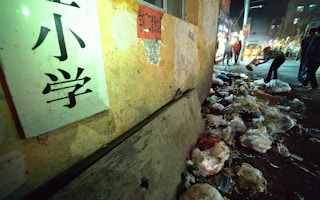Chinese scientists have found a way to harness wind power when there is no wind, just a gentle breeze: one way in which human ingenuity helps the climate crisis towards a resolution.
There are others. Californian researchers have tested a copper wire catalyst that can convert carbon dioxide into ethylene. In effect, fuel exhaust could fuel industry − and help contain global heating.
And a team in the US Midwest has begun a military project to develop a portable system that could turn waste plastic and paper into food for soldiers in the field. If it works, it could add new resonance to the term “iron rations” and deliver another answer to the challenge of plastic waste.
All three advances are so far on a very small scale. Two of them depend on nano-engineering, the making of materials at scales of a billionth of a metre, while the third calls on help from the microbial world. None of them is yet near commercial exploitation.
But all of them are yet further examples of the astonishing ingenuity and resource at work in the world’s laboratories and universities, in pursuit of ways to recover energy, reduce fossil fuel dependence, recycle detritus, and contain climate change.
“
Our intention isn’t to replace existing wind power generation technology. Our goal is to solve the issues that traditional wind turbines can’t solve.
Ya Yang, researcher, Chinese Academy of Sciences
Wind power worldwide is now big business, but not on days when there is no wind. Researchers in Beijing, Chongqing, Shanghai and Singapore write in the journal Cell Reports Physical Science that they have created a nanogenerator that can salvage energy from a breeze as mild as 1.6 metres a second. Worn on a sleeve, it could generate energy to power a cellphone while its wearer walks along a street
It works on a principle known as the tribo-electric effect. There is no turbine. Two plastic strips in a tube flutter and collide against each other in an airflow. When separated from contact, these two strips become electrically charged, and the energy can be captured and stored. The prototype can already power 100 LED lights and temperature sensors. It could be scaled up to 1000 watts.
“Our intention isn’t to replace existing wind power generation technology. Our goal is to solve the issues that traditional wind turbines can’t solve,” said Ya Yang, of the Chinese Academy of Sciences.
“Unlike wind turbines that use coils and magnets, where the costs are fixed, we can pick and choose low-cost materials for our device. Our device can be safely applied to nature reserves or cities, because it doesn’t have rotating structures.”
Quicker reaction
Ethylene is a chemical used to make plastics, solvents and cosmetics. Scientists report in the journal Nature Catalysis that they have exploited specially-shaped copper surfaces to reduce carbon dioxide (CO2) to ethylene, C2H4. Other researchers are attempting to turn CO2 into methane, or even jet fuel. Methane, or natural gas, is used industrially to make ethylene.
The latest study aims to cut out the natural gas, and make ethylene directly: world demand stands so far at 158 million tonnes, for plastic packaging or polyethylene, and other products.
“The idea of using copper to catalyse this reaction has been around for a long time, but the key is to accelerate the rate so it is fast enough for industrial production,” said William Goddard, of the California Institute of Technology, and one of the authors.
“This study shows a solid path towards that mark, with the potential to transform ethylene production into a greener industry, using CO2 that would otherwise end up in the atmosphere.”
The ambition to convert plastic and paper waste into food is so far just that, an ambition: the US Defense Advanced Research Projects Agency (DARPA) has put up $2.7 million (£2.1m) towards a co-operative effort to solve a rubbish problem and deliver edible single-cell food rich in proteins and vitamins.
Appetite for plastic
Yeast is a nourishing single cell protein. So is the spread popular with Australians, called Vegemite. What the US researchers want is a system that soldiers could carry into the field, and concentrate waste into mouthfuls of high-protein nourishment. It is based on trials with biomass pyrolysis to turn paper into sugar, and the conversion of plastics into fatty compounds with heat and a little help from microbes.
“Plastics are in fact biodegradable but the process is very slow, as evidenced by the accumulation of plastic waste in the environment,” said Robert Brown of Iowa State University, principal investigator.
“We can dramatically increase oxo-degradation of plastics to fatty compounds by raising the temperature a few hundred degrees Fahrenheit. The cooled product is used to grow yeast or bacteria into single cell proteins suitable as food.”
The system would, the researchers say, “improve military logistics resiliency and extend military missions.” Beyond that, it could go a long way to helping with the challenge of growing plastic waste worldwide, and creating an extra source of food for an increasingly hungry world.
This story was published with permission from Climate News Network.








